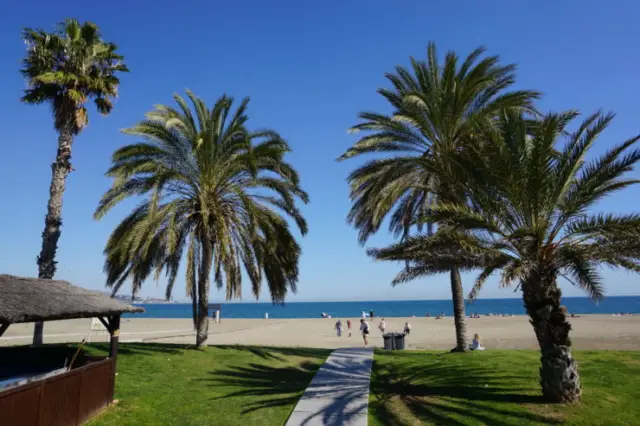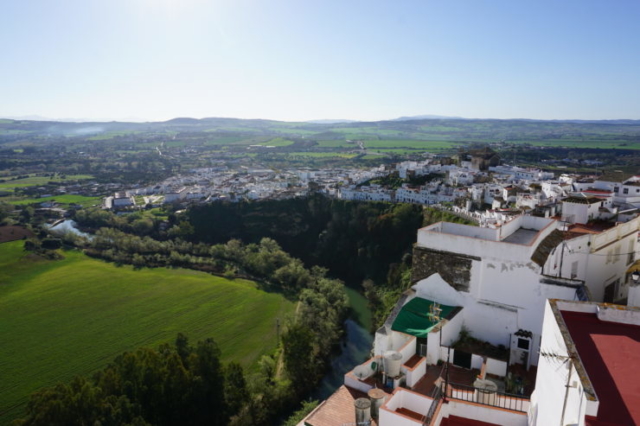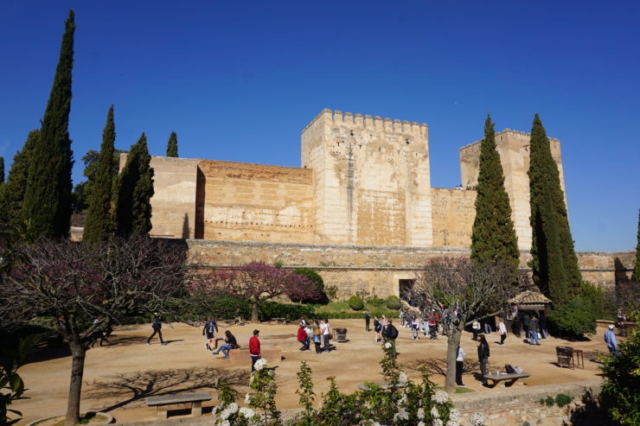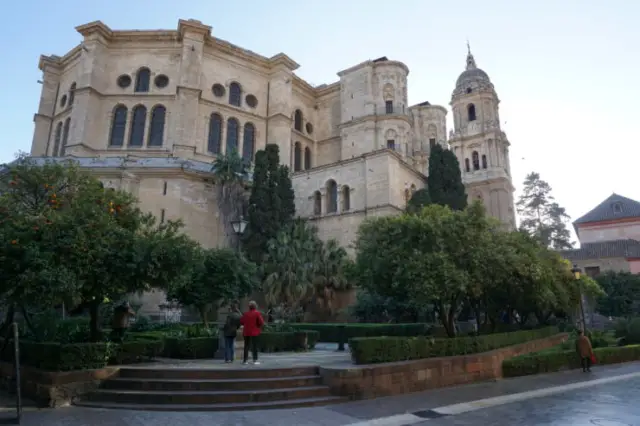Description
This is our one week Andalusia itinerary from last spring with some hiking, beachtime and awesome Tapas Bars. It’s best to have a rental car and to stay in small villages along the road wherever it makes sense.
| Our One Week Andalusia Itinerary |
|---|
| Day 1: Arcos de la Frontera & Ronda |
| Day 2: Caminito del Rey & around El Chorro |
| Day 3: Granada |
| Day 4: Malaga |
| Day 5-7: Mirador del Estrecho, Tarifa & Costa de la Luz |
Gallery
Overall costs
$ 1300
Duration
7 days
Rating
Itinerary:
Arcos de la Frontera
We arrived in Jerez but there was no good accommodation for one night so we decided to look for a place on the way to Ronda and got a room in the old center of Arcos.
Arcos is a charming little town on a rock next to a small lake and is one of the famous white villages of Andalusia. They had a carnival party in the streets that night so Arcos was definitely a good choice.
While Arcos is a nice place you won’t need much time to see it. After we saw most of the old town in the evening, we just made a quick walking tour in the morning and hit the road towards Ronda.
How to get there
By car: We rented our car at the airport in Jerez de la Frontera and drove around half an hour to Arcos. You can also drive down from Seville which takes around 1 hour and 20 minutes.
Get around
The old part of Arcos has very narrow streets mainly one-direction only so your best option is walking. Even the lake is easily reachable by foot on a short walk.
Things to do
Plaza del Cabildo: The main square of Arcos is more like a big parking lot for taxis but on its edge is a really nice balcony with great views over the surrounding landscape.
Basílica de Santa María de la Asunción: The biggest church of Arcos was built on a former mosque. Unfortunately, we couldn’t get in since there was a big ceremony going on that day (We’ve been there on a Sunday).
Ronda
Ronda is the most famous white village of Andalusia but more likely a proper town due to its size. The town lies on a plateau which is divided by a narrow canyon. The bridge that connects both parts is therefore the landmark of Ronda (Puente Nuevo).
To see the main sights, you will need around half a day. After visiting Ronda, we drove to El Chorro where we’ve spent the next two nights.
How to get there
By car: You can either drive around one hour to Ronda when bypassing the Sierra de Grazalema or one hour and 30 minutes if you go through the mountains. We choose to take the road to El Bosque and from here via Grazalema to Ronda. It’s a very scenic drive so we stopped several times to take some pictures. It seems to be a nice hiking area so in case you have some extra time it might be worth spending it here.
In Ronda we used Parking Martínez Astein which is guarded and just a walk through the pedestrian zone away from the bridge.
Get around
Ronda’s’ main sights are all pretty close together so walking is by far the best option to get around.
Things to do
Puente Nuevo: The bridge is best seen from the walkway around Hotel Parador de Ronda or if you decent a bit from the other side to the viewpoint Mirador Puente Nuevo de Ronda.
Iglesia de Santa María la Mayor: The church’s roof has an accessible terrace with benches to relax and great views towards the Sierra de Grazalema. This posts title picture was taken here.
Plaza de Toros de Ronda: Ronda’s bullfighting arena is an impressive building and also hosts a museum about bullfighting history. Both places have separate entrance fees. We skipped the pretty expensive museum and just visited the arena.
Caminito del Rey
This hiking trail was once one of the most dangerous ones in the world. Check out this YouTube video from 2008. Today the whole way is newly built and not dangerous at all. It’s still a very impressive hike and one of the best things you can do around Malaga.
How to get there
By car: From Ronda to El Chorro it’s a little bit more than an hour to drive.
By train: The regional train between Malaga and Seville stops in El Chorro.
How it works
Tickets are limited so make sure to preorder them in advance. The trail is closed on Mondays!
We bought our tickets at the Hotel and Restaurante La Garganta which was also our accommodation for these two days.
The tickets included a bus ride to the starting point of the trail. The bus leaves from El Chorro train station to a restaurant from where you walk back up the road until you see a small pedestrian tunnel to the right. Go through the tunnel and follow the path for around 15 minutes until you reach the official start and ticket control.
Tickets are valid for a specific time so make sure to be there on time. Once you’re started just follow the trail through the canyon until you are back in El Chorro. Plan half a day for the entire tour.
Around El Chorro
El Chorro is a really small village on a water reservoir with just a few houses and a train station. The area around El Chorro has some of the biggest water reservoirs for Malaga, lots of pine trees and some beautiful hiking trails.
Things to do
Torcal de Antequera: The Natural Park Reserve has some of the most impressive karst landscapes in Europe and can be explored on two hiking trails. Both start and end at the parking lot. They share the same paths for most of the time while one makes a bigger loop. Walking time for the longer trail was around 2 hours.
To get there you will need a car. Driving from El Chorro takes around one hour.
Álora: The old town of Álora has some typical white washed walls, narrow alleys and lots of places to eat.
Granada
Granada is famous for its Tapas and the Alhambra which is a former palace from the time when Andalusia was part of the Muslim Nasrid dynasty.
Granada is located just next to the Sierra Nevada which has snow covered peaks from late autumn until spring and is a really nice hiking area.
How to get there
By car: Driving time between El Chorro and Granada is around 2 hours. The first 20 minutes through the hills are pretty scenic and after that it’s just easy rolling on the highway. In Granada we used one of the parking lots below Avenida de la Constitución.
Get around
Walking is the only reasonable way to get around in the old part of Granada though there are small busses if you want to avoid walking up the steep hills. For the Sierra Nevada I would recommend to go there after your stay in Granada to avoid driving twice through the city.
Things to do
Alhambra: The hilltop fortress was built during the Muslim Nasrid dynasty in the 13th century and is one of the most impressive architectural sights in Spain. You have to buy tickets online in advance and for some parts like the Palacios Nazaries they are sold out weeks and months in advance. But for the general entry I once managed to buy them via phone just the minute before entering.
Mirador San Nicolás: This little balcony offers some of the best views of the Alhambra and the high mountains of the Sierra Nevada in the background.
Tapas Bars: Granada has some of the best Tapas Bars in the country. My favorite ones are Bodega La Mancha close to Plaza Nueva and Los Diamantes next to Plaza del Carmen.
Sierra Nevada: The Sierra Nevada reaches a height of 3479 meters and is a nice hiking spot during the summer. It’s also a good call if you want to escape the summer heat down in Granada. During the winter its Southern Spain’s most popular ski destination.
With two additional days you can drive behind the Sierra Nevada and visit Europe’s only real desert (Desierto de Tabernas).
Malaga
We left Granada in the morning and drove down to Malaga via Motril mainly to see the Sierra Nevada from the south and because half of the drive goes along the coast.
Malaga has a laid-back vibe and after a day of walking through Granada we headed directly to the beach Playa la Malagueta for lunch and to relax a little bit. After that we walked through the historic center, up to Gibralfaro viewpoint, Alcazaba and had some Tapas at La Tranca.
How to get there
By car: Inland driving time is 1 hour and 30 minutes and the route along the coast is roughly 20 minutes longer.
Get around
As long as you stay around the city center walking is the best option. For a trip to one of the beaches in the suburbs I would recommend to rent a bicycle.
Things to do
Alcazaba: The old fort from the 11th century lies next to the port on a hill with great views over the city. Entry is 2.10 Euros; the place is closed on Monday bus has free entry Sunday after 2pm.
Playa la Malagueta: Solid beach for a town with half a million inhabitants. Its located just around the corner from the newly built shopping center at the Cruise Terminal. There are lots of small bars serving snacks and drinks but just a few spots with shadow.
Old town: The old part of Malaga has a beautiful cathedral and many streets in the shopping district are pedestrian zones. The best places to eat are located around the shopping area, for example La Tranca Tapas Bar.
Mirador del Estrecho / Tarifa
If you drive from Malaga to the Atlantic Ocean you will drive over some hills just after passing Gibraltar and Algeciras. You will recognize a significant drop of temperatures and often strong winds. These hills are a part of the Strait of Gibraltar and separate the Mediterranean climate from the slightly colder and windier one of the Atlantic Coast.
On top of the hills is a small café and a terrace with views over the Strait of Gibraltar (Mirador del Estrecho). On clear days you can see the ships passing through with the big mountains of Jebel Musa in Morocco.
The first town after you passed the hills is Tarifa and due to its year-round strong winds, it’s one of the best spots for kite and wind surfers in Europe.
We stopped at the viewpoint and in Tarifa on our way to Santi Petri and sat in the sand to watch the kite surfers at Playa De Los Lances.
How to get there
By car: N-340 from Algeciras to Tarifa. Driving time from Malaga is around 2 hours.
Get around
To access the viewpoint Mirador del Estrecho, you should have a car or bicycle since it’s just next to the road and there’s not much around it. For a stroll through Tarifa use the free parking at Glorieta de Leon and walk into the old town (~5 minutes) and afterwards to the beach.
Things to do
Mirador del Estrecho: Enjoy the view over the Strait of Gibraltar with a coffee or beer at the kiosk.
Tarifa: Tarifa has a charming old town with North African architecture like city walls and impressive city gates. Just walk through the narrow alleys and enjoy some beach time afterwards.
Ferry to Morocco: You can take one of the ferries to Morocco and spent a day in Tanger. The fastest boat makes the journey in 35 minutes but check custom regulations in advance. You can check out the Morocco part of our Eurail itinerary which also started in Tanger or a short trip to Fès if you want to proceed from here.
Costa de la Luz
The Atlantic Coast of Andalusia is called Costa de la Luz and has some of the best beaches in all of Spain. We stayed in Santi Petri which is a tourist area but in March most hotels were closed and the beaches were almost empty. Spring and autumn are great times to be here due to its constant sunny and warm weather.
How to get there
By car: Depending where exactly you want to go its around 3 hours from Malaga and 1.5 hours from Seville.
By plane: Closest airport is located in Jerez de la Frontera but also Seville and Malaga can be used to get there.
Get around
We used rental bikes to explore the area and to switch between the beaches. For a visit in Cadiz or anywhere else inland I would recommend to use a car.
Things to do
Surfing: Tarifa and Palmar have lots of surf schools and rental shops. Waves are suited for beginner and intermediate levels but can vary great throughout the year. I’ve been there several times and would consider October and November to be the best time for surfing with warm water and good waves.
Cycling: The backcountry between Vejer de la Frontera and Parque Natural Los Alcornocales is a popular cycling area. Guided tours can be booked for example at Huerzeler Bicycle in Chiclana.
Sherry tours: Sherry tasting trips can be made around Jerez with transfer services. We stopped at Bodega Manuel Aragón which has a nice garden for tastings.
Cadiz: The city has a great location at the end of a peninsula which is accompanied by a sandy beach. Just walk around the streets and enjoy the many shops and restaurants. If possible, go to Mercado Central de Abastos around noon on a Saturday and enjoy Tapas with the locals.





































